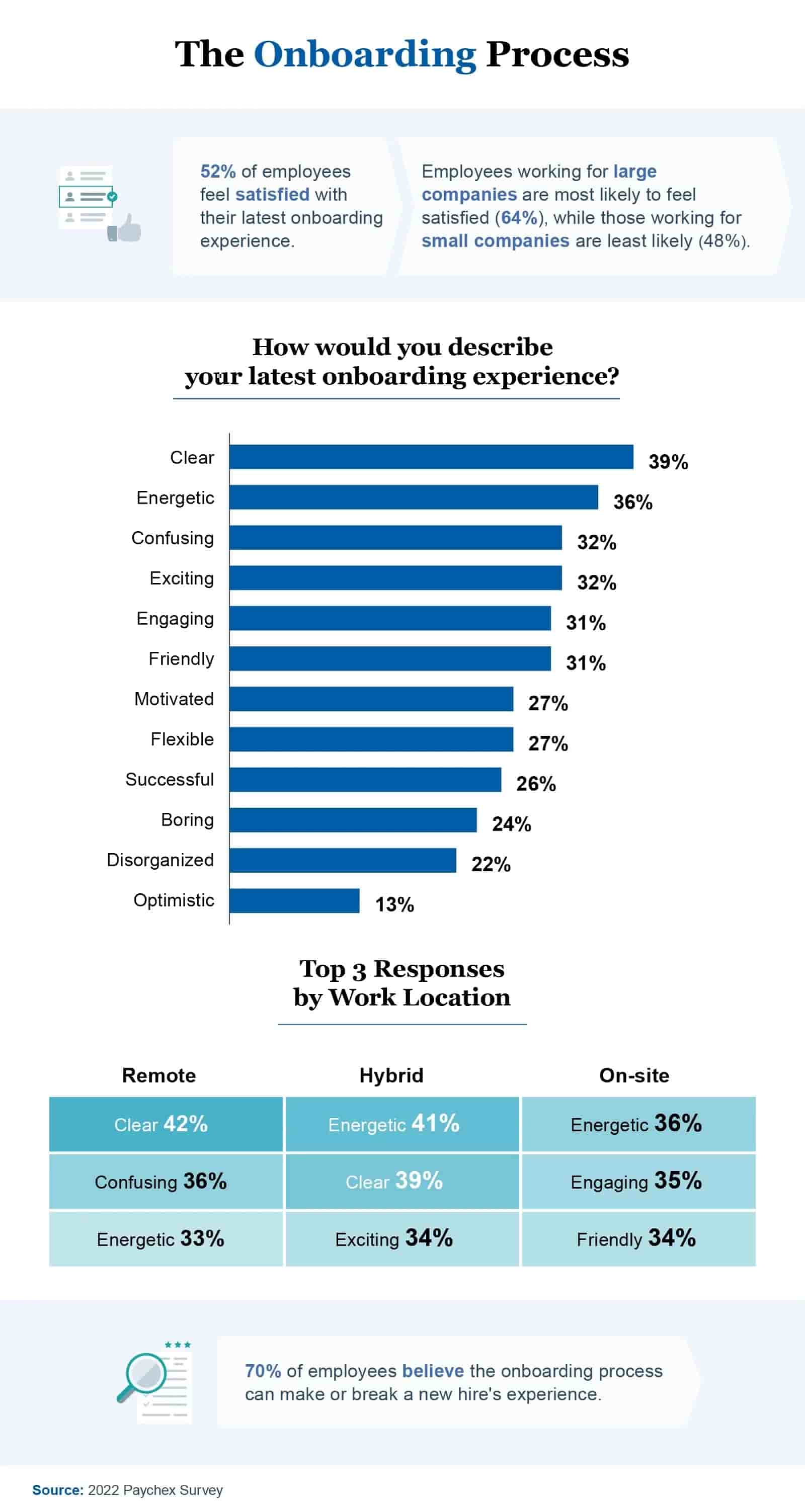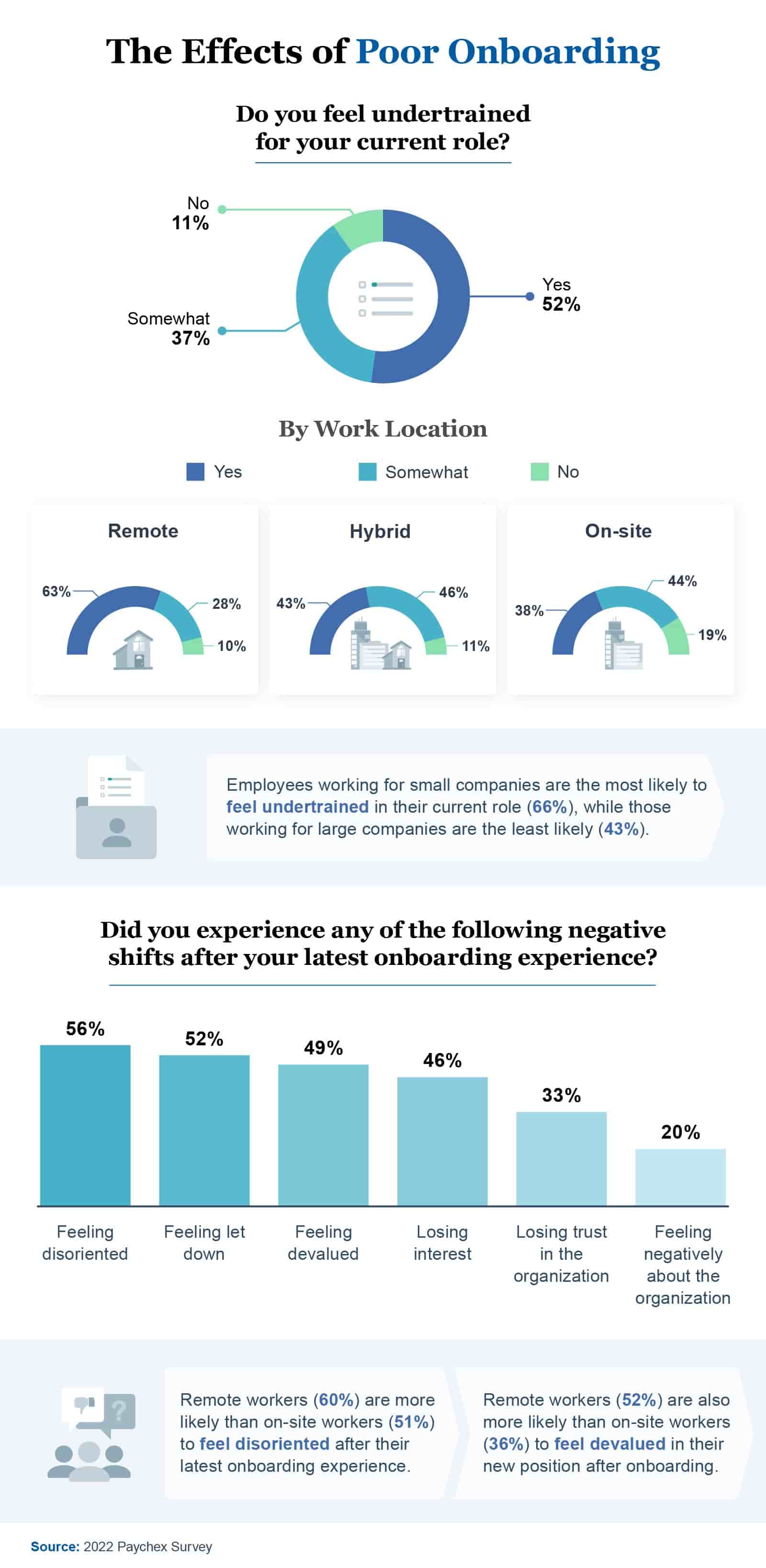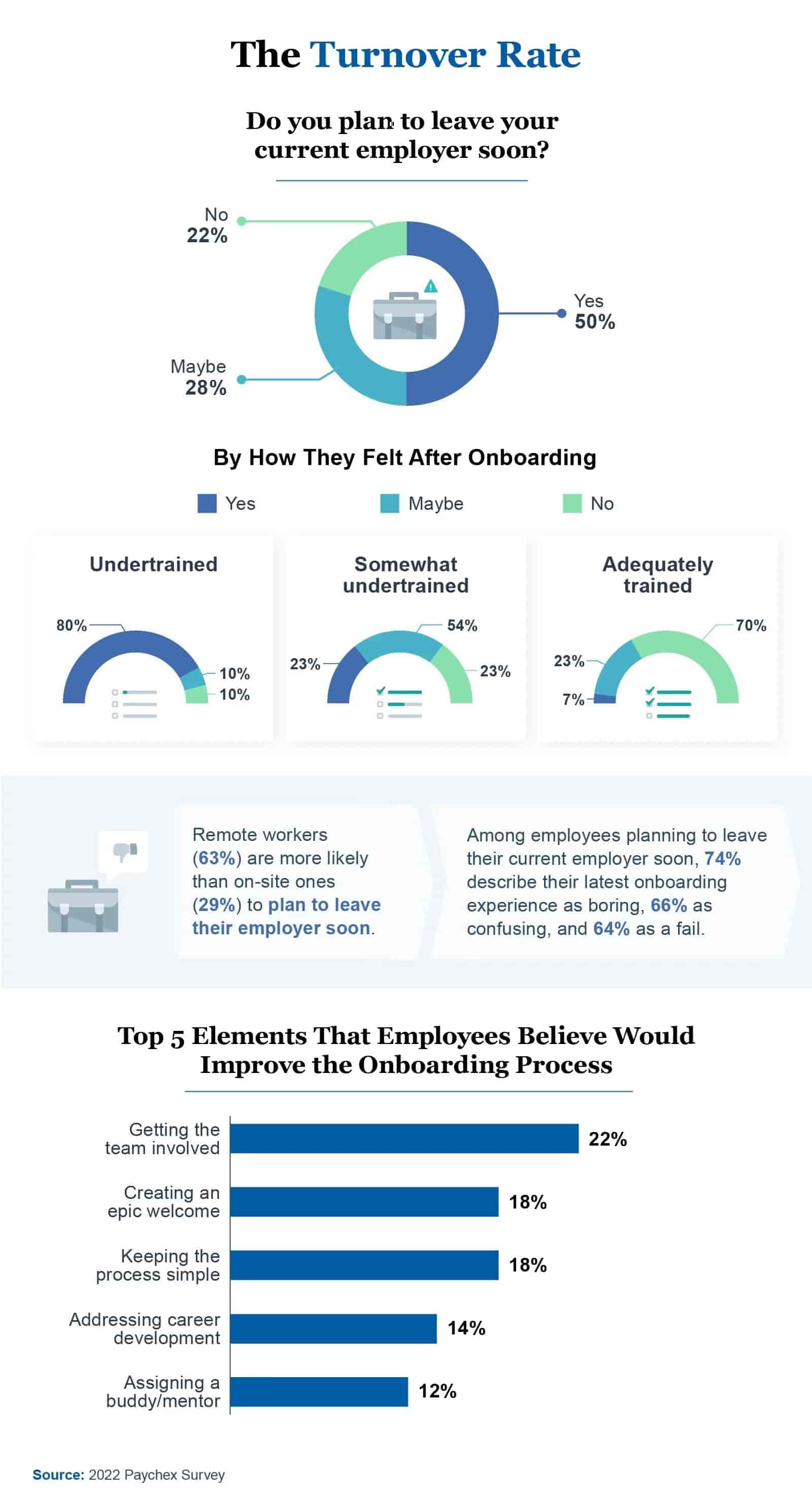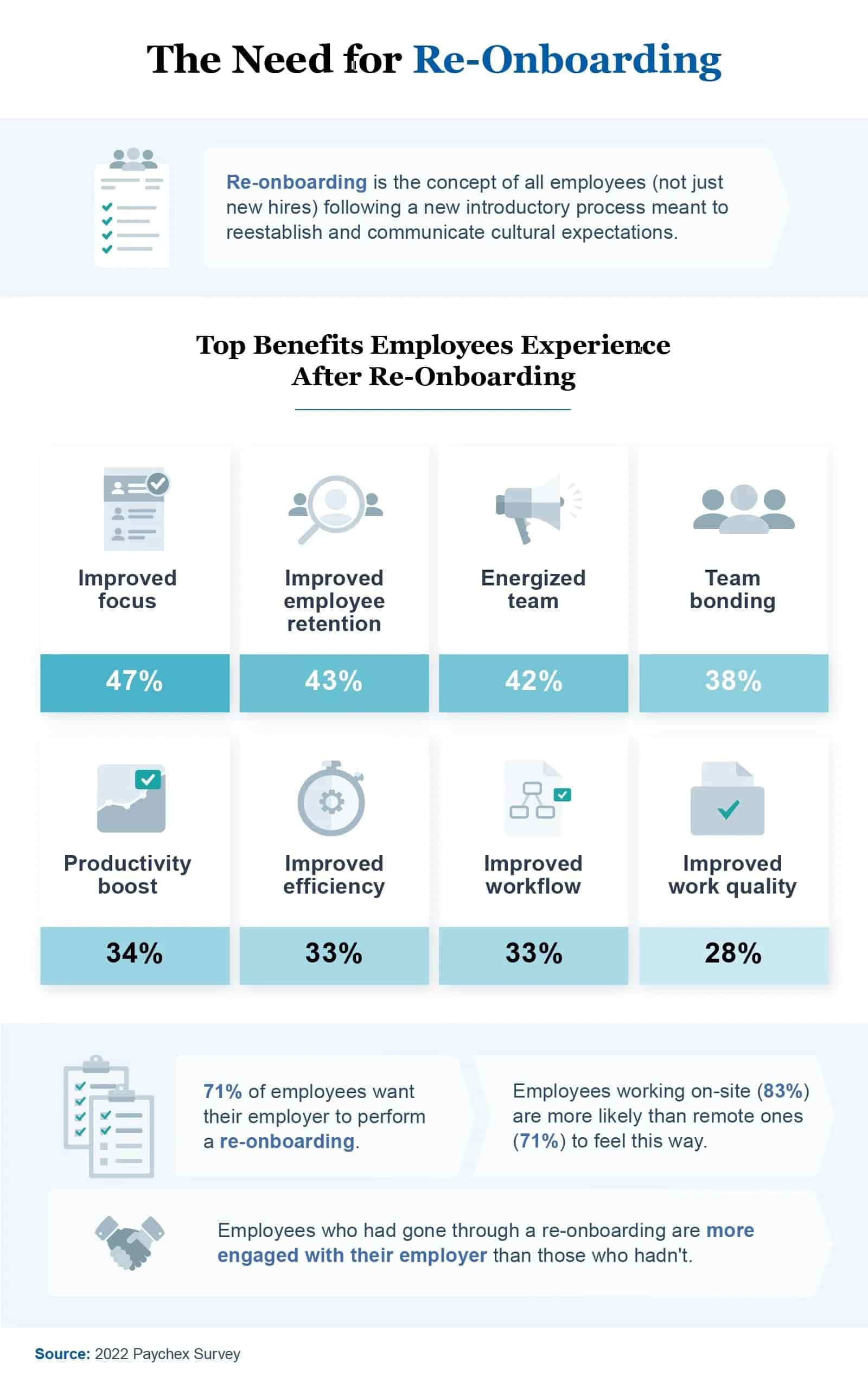Starting a new job can be exciting and hopeful, but poor onboarding can leave eager employees feeling confused and disappointed. How does poor onboarding affect new hires and contribute to turnover? What can managers do to make onboarding an engaging, informative, and affirming experience? To find out, we surveyed 1,002 working Americans who started their current job within the past year and asked how their onboarding experience affects their job and what could be done better.
Key Takeaways
- Remote employees are more likely than on-site ones to feel undertrained.
- Employees working for large companies are more satisfied with their onboarding than employees in small companies.
- Nearly one-third of employees find the onboarding experience confusing.
- Remote employees are 117% more likely than on-site employees to plan to leave their employers soon.
First Impressions
The onboarding process can tell new employees all they need to know about a workplace: company culture, workplace morale, managerial support, advancement outlook, and team unity (or lack thereof). With this in mind, how many companies use the onboarding process to their advantage, and how many fail?

Despite the importance of onboarding, only about half of all new hires feel satisfied with the onboarding experience at their current job (52%). While 39% find the onboarding clear, 32% find it confusing, and 22% find it disorganized. On-site and hybrid employees fare better during onboarding than remote workers, 36% of whom found the process confusing. This might add fuel to the argument for returning employees to the workplace.
In terms of how workers in different sectors/industries feel, more than half of finance industry employees (54%) are most likely to be satisfied with their onboarding experience, compared to only 31% of employees in the business industry.
Generationally, Gen Zers are the most likely to feel satisfied (62%) compared to just 43% of Gen Xers. Human resource departments should keep this potential generational gap in mind when onboarding new hires and consider offering them additional training and on-the-job support.
Onboarding Gone Wrong
No matter the generation or industry, the effects of poor onboarding are universal. How does a negative onboarding experience affect the attitudes of new employees?

Perhaps the most significant effect of poor onboarding is employees feeling undertrained (52%). Employees working for small companies (66%) are the most likely to feel undertrained. This is likely a byproduct of small businesses not having the same HR resources as larger companies and an example of where outsourcing HR can help smaller businesses compete with their larger competitors.
In terms of where employees work, remote workers are the most likely to feel undertrained (63%). They’re also the most likely to feel disoriented (60%) and devalued (52%) after onboarding. Given the large percentage of employees who prefer remote work, companies may want to refine their remote onboarding process to fill in these gaps.
Generationally, Gen X feels the most undertrained after onboarding (58%), echoing their high rate of dissatisfaction with the onboarding experience. Just over half of Gen Z and baby boomers feel undertrained (55%), and so do 45% of millennials.
Pushing New Hires Out the Door
With so many new hires feeling dissatisfied and undertrained after the onboarding process, what are the next steps for these employees?

When onboarding fails to meet the expectations of a new hire, the next step for many employees is to leave. While a staggering 50% of newly hired employees plan to quit soon, that number skyrockets to 80% for those who feel undertrained from poor onboarding. Conversely, only 7% of those who feel well-trained plan to leave their job soon, and 70% plan to stay. Millennials are the least likely to leave (43%) of the generations we surveyed.
We also saw similarities between employees’ undertraining rates and plans to quit based on the size of their company. As we’ve seen, people working for small companies are the ones most likely to feel undertrained. But they’re also far more likely to plan to leave their employer soon (59%) compared to large-company employees (38%).
The one outlier in these statistics is Gen Z. Though they feel the most satisfied with their onboarding experience, they’re also the most likely to plan to leave their job soon (58%). It seems that onboarding is more of a make-or-break experience for new hires of older generations in particular.
Is It Time to Re-onboard?
While proper onboarding is essential for new hires, the process can benefit the entire company. Re-onboarding puts all employees through the onboarding process again, no matter how long they’ve been working for the company. Let’s take a look at the benefits of re-onboarding.

Re-onboarding is an excellent way to engage and check in with your team. Afterward, employees are more focused (47%), energized (42%), productive (34%), and efficient (33%). Re-onboarding also increases employee retention by 43%, which helps reduce the need for new-hire onboarding.
The Onboarding Experience
Onboarding is a new hire’s introduction to their new workplace and position. A positive experience can affirm a new employee’s excitement and motivation, but a negative one can send them running for the exit. While onboarding is essential for every new hire, remote workers, mature employees, and employees at small companies require especially careful onboarding to ensure they feel prepared and valued in their new roles.
As companies refine their onboarding processes, creating a welcoming, engaging, and clear onboarding experience can vastly improve employee retention and morale. Onboarding can also boost productivity and teamwork, even for long-standing employees. Customizable onboarding software may make the process smoother for employers and employees. With proper onboarding, a company can help employees — new and old — remain motivated, feel part of the team, and want to stick around.
Methodology
For this campaign, we surveyed 1,002 employed Americans that have started working for their current employer within the past year. Among them, 43% were women, and 57% were men. The work situation breakdown is 10% on-site, 47% remote, and 43% hybrid. The company size breakdown is 7% small, 54% medium, and 9% large companies. This survey was fielded from Oct. 7, 2022 to Oct. 14, 2022.
About Paychex
Paychex is a leading provider of integrated human capital management solutions for payroll, benefits, human resources, and insurance services. Founded over four decades ago, Paychex simplifies the complex processes of running a business, so you can focus on what matters most. Paychex digital onboarding software provides a custom experience for new hires, keeping them engaged after the job offer and ready to start job-related tasks on day one.
Fair Use Statement
Are you working to improve your company’s onboarding experience? Feel free to share this article with anyone you’d like. We just ask that you do so for noncommercial purposes only and provide a link back to this page to give the authors their due credit.













